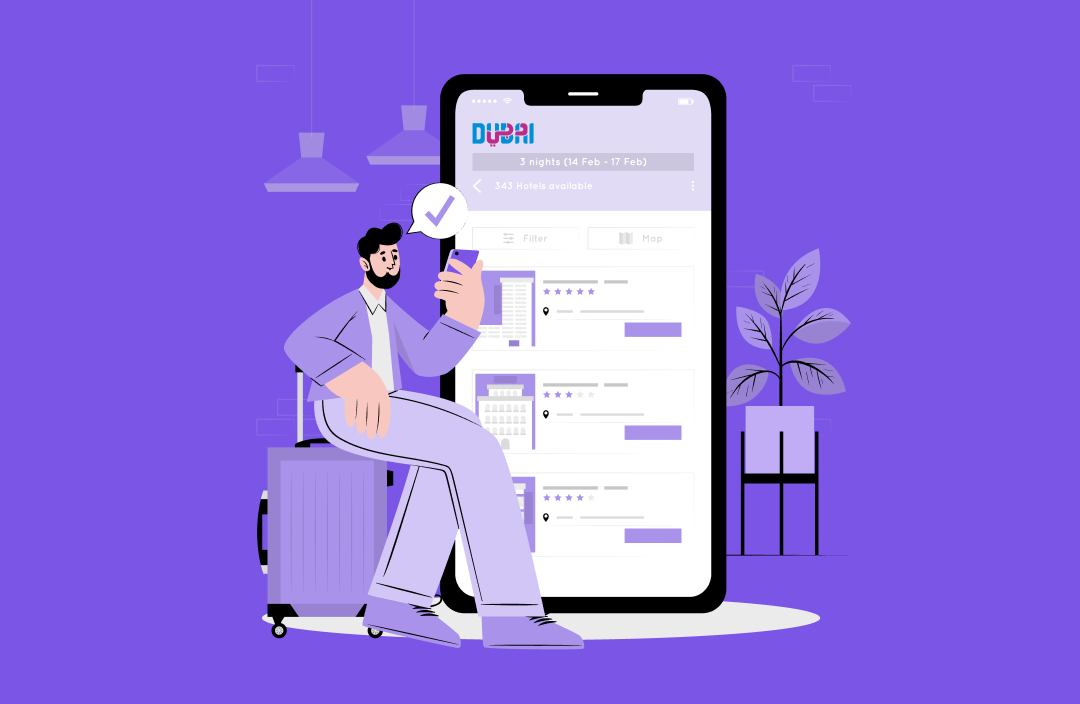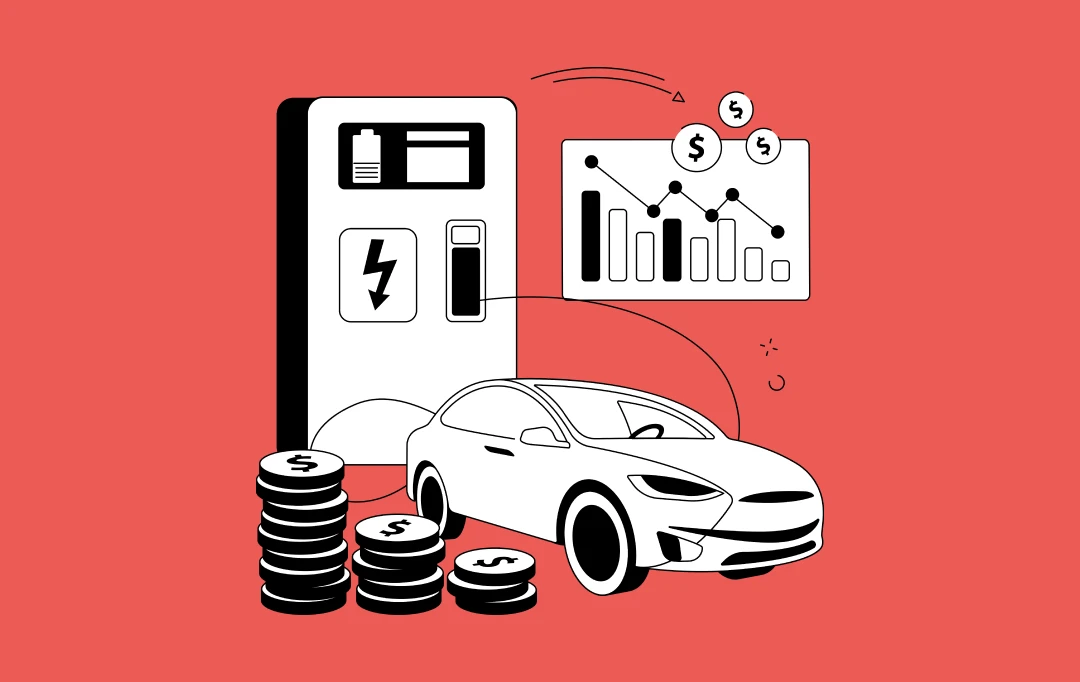Key takeaways:
- Steps to Build: Empathize with users, define niche, design intuitive UX, choose scalable tech stack, develop lean MVP, test rigorously, and launch regionally with analytics-driven iteration.
- Costs: Basic MVP ($40K–$100K), feature-rich app ($150K–$300K), enterprise-grade ($400K–$500K+), with 15–20% annual maintenance costs.
- Core Features: Real-time discovery, intelligent filtering, route planning, user ratings, seamless payments, reservations, notifications, personalization, and admin dashboard.
- Challenges & Monetization: Overcome data, geolocation, payment, privacy, and hardware challenges; monetize via transaction fees, subscriptions, ads, and anonymized data sales.
The electric vehicle revolution isn’t coming – it’s already here. With over 3 million EVs on American roads and ambitious federal goals aiming for 500,000 public chargers by 2030, one thing is clear: the future runs on batteries.
However, as EV adoption grows, so does a key challenge: finding a charging station when and where it’s needed. Range anxiety hasn’t disappeared; it’s just shifted. Now, drivers worry more about access than battery life. This is where EV charging station finder app development becomes more than just a convenience – it becomes a lifeline.
For entrepreneurs, this moment presents a massive opportunity. By building a solution that helps EV users locate chargers in real-time, check availability, get directions, and pay seamlessly, you’re not just meeting a need – you’re stepping into a rapidly growing market with recurring user engagement and potential for long-term scalability.
EV Charging Apps Development Market Insights
The electric vehicle charging station finder app development is experiencing unprecedented growth in the United States, presenting a significant opportunity for entrepreneurs to develop solutions that address emerging challenges, chief among them, the need for accessible and reliable charging infrastructure.
- EV Adoption Accelerates: In 2024, Americans purchased approximately 1.6 million electric vehicles, representing a 10% increase from the previous year and accounting for over 10% of all new car sales.
- Charging Infrastructure Expansion: As of early 2024, there are over 192,000 publicly available charging ports, with approximately 1,000 new public chargers being added each week. Despite this progress, the current infrastructure still falls short of meeting the projected demand.
- Future Demand and Government Goals: EV charging station app development trends indicate that the U.S. will need approximately 1.2 million public chargers by 2030 to meet the anticipated demand.
In this article, we’ll take you through the entire roadmap to app development for finding electric vehicle charging stations – from feature planning and data integrations to monetization models and go-to-market strategy. Whether you’re a first-time founder or a serial entrepreneur in the mobility space, this guide will help you plug into the opportunity with confidence.
How to Design for Trust, Speed, and Simplicity?
When it comes to EV drivers, the design part of the process for EV charging station finder app development isn’t just about aesthetics – it’s about eliminating decision fatigue, increasing confidence, and making every interaction feel effortless.
Most users will open your app while driving or en route, so your interface needs to be fast, focused, and familiar, with zero tolerance for friction.
Here’s how you should think about design if you’re building an EV charging station finder app that people will use (and recommend).
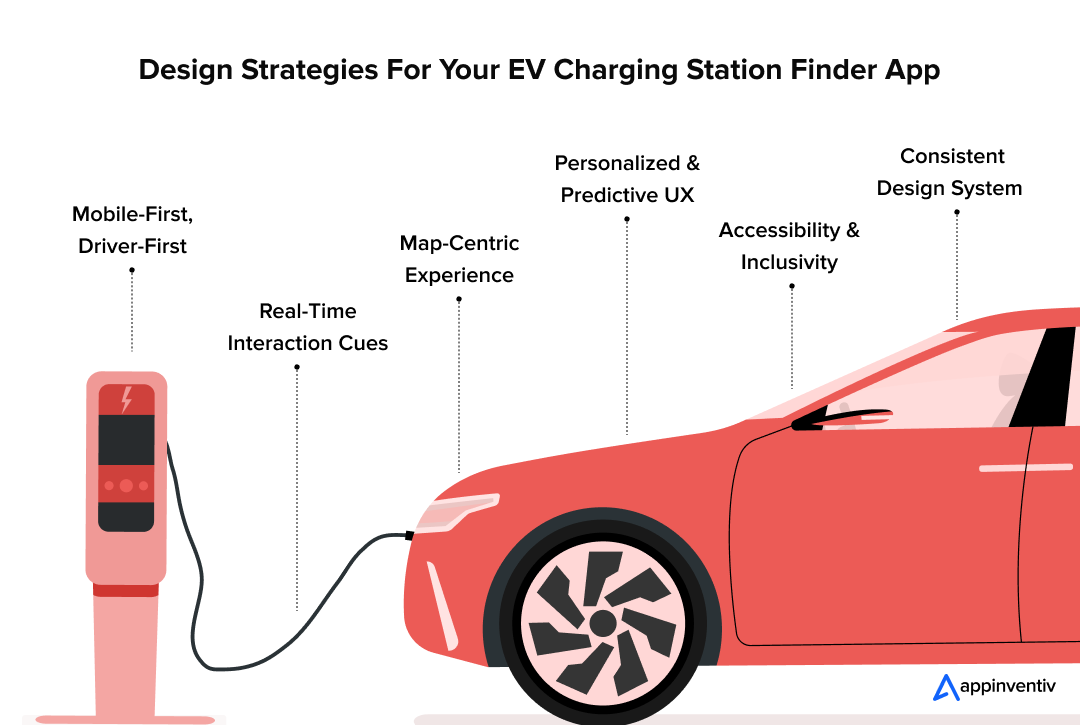
Mobile-First, Driver-First
Your app will almost always be used on the move. That means it should be designed with mobile-first principles, featuring big, readable fonts, one-handed usability, and minimal taps to key actions.
- Minimize text-heavy screens – favor iconography and quick-glance visuals.
- Ensure all critical actions (like “Navigate,” “Start Charging,” “Pay”) are visible above the fold.
- Use voice-based navigation and eliminate buttons and menus.
Real-Time Interaction Cues
Whether it’s a charger status update, a failed payment, or a navigation reroute, your UI should respond to the user in real-time. No spinning wheels or silent failures.
- Show live status badges (e.g., “Occupied,” “Available,” “Offline”) with color indicators.
- Use toasts and alerts for fast feedback (e.g., “Payment successful,” “Station unavailable”).
- Add micro-animations to make transitions feel alive, but never delay the function.
Map-Centric Experience
The map is your interface. Everything else supports it. A clean, responsive map experience that shows relevant information at a glance is crucial.
- Cluster pins for dense station areas to reduce clutter.
- Allow long-press interactions to display charger information or quickly plan routes.
- Include dynamic labels like “5 mins away,” “2 slots open,” or “Fast charger” directly on the map.
If your map is laggy or confusing, the rest of your app won’t matter.
Personalized & Predictive UX
Design is no longer just reactive – it should be proactive. If a user drives the same route daily, your app should surface preferred stations or suggest off-peak hours for cheaper charging.
- AI in automotive enables the tracking of behavior and vehicle preferences to auto-filter stations.
- Suggest stations based on predicted charging needs (e.g., “You’ll need a charge in 2 hours – station X is on your route”).
This level of design requires both a strong backend and thoughtful front-end logic, but it creates stickiness that utility-focused apps often lack.
Accessibility & Inclusivity
Don’t overlook accessible and voice user interface design. From color contrast and text scaling to voice controls and screen reader compatibility, these standards are non-negotiable if you want widespread adoption and app store approval.
- Follow WCAG 2.1 guidelines for accessibility.
- Include dark mode for night-time drivers.
- Allow voice-based commands for hands-free use in future releases.
Consistent Design System
A design system ensures that every component—button, card, filter, and tooltip— is consistent across devices. It saves you money, speeds up development, and creates a unified experience.
Use tools like:
- Figma or Sketch for prototyping
- Material Design (if Android-first) or Human Interface Guidelines (for iOS)
- Tailored component libraries if you plan on cross-platform with Flutter or React Native.
The Tech Stack to Build an EV Charging Station Finder App
The development journey is not just about building an EV charging finder app with Google Maps integration, connecting maps to chargers. You’re building a location-based, real-time, payment-enabled utility platform – with multiple data sources, live updates, and potentially thousands of users accessing it simultaneously. That means your tech stack has to be modular, cloud-native, and ready to scale.
Here’s what you’ll likely need across the different layers of the EV charging station finder application development stack:
1. Frontend
- Frameworks:
- Maps Integration:
- State Management:
- Redux, MobX, or Provider (Flutter)
2. Backend (Server-Side Logic)
- Languages & Frameworks:
- Node.js or Python (FastAPI/Django)
- Go.
- Hosting & Infrastructure:
- API for EV Charging Station Locator App and Charger Data:
- Open Charge Map API
- NREL’s AFDC API
- Hubject
- ChargePoint, EVgo, Greenlots, etc.
3. Database & Real-Time Layer
- Primary Databases:
- Real-Time Data Handling:
- Firebase Realtime Database or Socket.IO
- Redis
4. Payments & Wallets
- Stripe
- Braintree or Square
- Roaming protocols like OCPI or OICP
5. Notifications & Messaging
- Firebase Cloud Messaging (FCM)
- OneSignal
- Twilio
6. Admin Dashboard & Analytics
7. AI & Personalization (Optional but Valuable)
- TensorFlow Lite or ONNX
- AWS Personalize
- OpenAI GPT API or Google Vertex AI
8. Security & Compliance
- OAuth 2.0
- JWT (JSON Web Tokens)
- SOC2-ready cloud stack
How to Approach the Process for EV Charging Station Finder App Development?
Once you’ve decided to build an EV charging station finder app, the natural next question is: where do you begin? The process isn’t just technical. It’s equal parts product strategy, market fit, user empathy, and scalability planning. Here’s how experienced founders approach it.
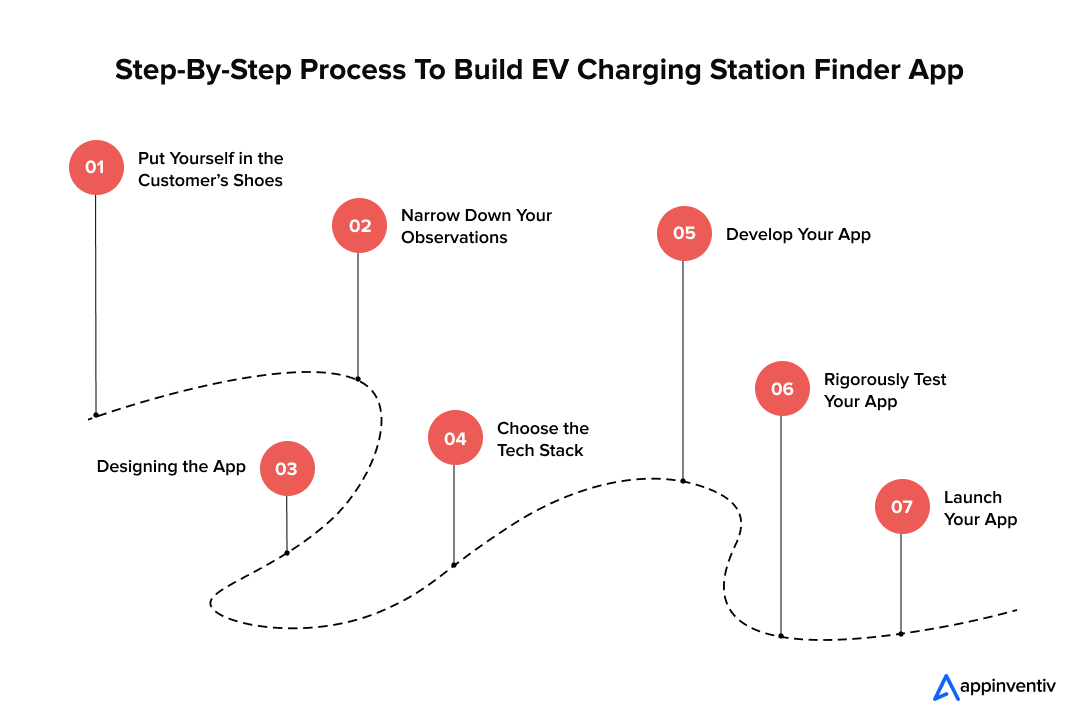
Put Yourself in the Customer’s Shoes
Steps to Develop an EV Charging Station Finder Mobile App begin by spending time in the problem space, not the app space. Download the top 5 apps in this category and use them like a first-time EV driver. This helps you understand the nuances, such as how EV ensures smart energy management, and more. Find their weak spots. Check Reddit threads, App Store reviews, and forums. Why do people switch between apps? What feels slow, outdated, or broken? This is your first source of insight, and you won’t find it in any roadmap template.
Narrow Down Your Observations
Once you’ve got a handle on what the market is tired of, narrow down your angle. Are you focusing on charger reliability? Local discovery in low-coverage areas? A better payment experience? Route optimization for delivery fleets? This clarity is what turns an idea into a product brief. Don’t skip it.
Designing the App
Design comes next, but not just the visual kind. You’re designing experience flows—how someone finds a charger while driving, how they filter options when low on battery, or how they get help when a charger isn’t working. These micro-moments are what define retention. Tools like Figma and InVision help at this stage, but real validation comes from letting 5–10 people walk through your wireframes. You’ll be amazed at what they find confusing that seemed “obvious” in the mockup.
Choose the Tech Stack
The app development tech stack, especially for EV charging station locator app development, should depend on how quickly you want to move and how deeply you want to integrate. A cross-platform approach, such as Flutter or React Native, can help you get to market faster.
But if you’re aiming for long-term performance (say, with in-car OS integration or real-time fleet monitoring), native development with modular backend architecture gives you more control. Your backend should be designed to accommodate third-party APIs (such as Open Charge Map, NREL, and Hubject), real-time data updates, and payment workflows from the outset, not as an afterthought.
Develop Your App
As you move into the development phase of the steps to develop an EV charging station finder mobile app, resist the urge to overbuild the first version. Start with the journeys that get users from Point A to Charge – search, navigate, charge, pay. Get those right, then layer in reviews, wallet top-ups, loyalty, and dynamic pricing.
Rigorously Test Your App
Has your mobile app passed the quality assurance? That’s why testing isn’t just about squashing bugs – it’s about field validation. Simulators won’t tell you what happens when GPS fails in a basement parking lot. Or how your map tiles load over 3G. You need test sessions that simulate edge conditions, and testers who aren’t afraid to tell you your UX is annoying.
Launch Your App
Launching a mobile app strategy matters more than many founders think. Start regionally – own one city before chasing 50. Partner with local charging networks or municipalities if possible. Build loyalty in a core zone, gather feedback, and then scale.
And once you’ve launched, don’t assume the job is done. Use analytics to track how people use the app versus how you thought they would. It’s the gap between those two that defines your next 6 months of roadmap.
What are the Core Real-time EV charging Station Tracking App Features
To build a charging station finder app that stands out, you need more than a polished UI or a pin-filled map. What users want is confidence and control—the ability to plan, locate, access, and pay for charging with minimal friction. For entrepreneurs, every one of these real-time EV charging station tracking app features isn’t just a functionality – it’s a touchpoint to build trust, drive engagement, and create monetizable opportunities.
Core Features of EV Charging Station App
Real-Time Station Discovery
This is the backbone of your app development for finding an electric vehicle charging station process. EV drivers need to see nearby stations based on real-time location data, ideally with live updates on how many chargers are available, their type, and whether they’re operational. Open APIs like Open Charge Map or the Department of Energy’s AFDC data can give you a starting point, but to truly stand out, you’ll want to consider partnerships with private charging networks that offer more reliable and granular data.
When your app can predict charger availability before the driver even reaches it, it stops being a tool and becomes a necessity. And with enough usage, you’ll have valuable analytics that charger networks might pay for – like traffic patterns, wait times, or driver preferences.
Intelligent Filtering
Not all electric vehicles (EVs) are built the same, and neither are their drivers. Some want the cheapest charging spot. Others need the fastest one. Many care about connector compatibility. Your app should offer smart filters for plug types, charging speeds, providers, payment methods, and even time-of-day preferences. The richer the filters, the more tailored the experience, and the more likely users are to stick around.
This also opens up possibilities for affiliate models in the electric vehicle charging station finder app development journey. For example, showcasing “green energy only” chargers or premium networks could be a paid placement, generating a revenue stream for your app without interrupting the user experience.
Route Planning with Charging Logic
Your EV charging station finder app can play a huge role in trip planning, especially for long-haul EV drivers. Route planning that factors in the vehicle’s battery capacity, terrain, weather, and elevation changes is becoming an expectation, not a luxury. Tesla nails this in-car. Your app can do it for everyone else.
Building your EV charging finder app with Google Maps integration and a custom EV logic can turn your app into a travel companion, not just a charger directory. This is also an area ripe for premium features, such as “auto-suggested charging stops,” “best route for fast charging,” or “minimum-cost route.”
Bonus Read: Route Planner App Development – Costs, Benefits, Features
Real User Ratings & Community Feedback
One of the biggest pain points for EV drivers? Inconsistent experiences. Some chargers are located in prime areas with nearby cafes, while others are hidden behind locked gates. Allowing users to rate and review stations provides new users with confidence, while also gathering data on station quality, safety, and user sentiment.
If you’re planning to scale the app, this review system can become its asset. Over time, it can be enhanced with AI to provide predictive insights, closing business gaps such as when a charger is likely to be offline or when a station typically experiences congestion.
Payments & Wallet Integration
Seamless payments are non-negotiable. Users should be able to start and end sessions without needing to switch between multiple apps. Integrating payments across various charging networks (via roaming agreements or APIs, such as Hubject) can give your app a significant competitive edge. If users can use one app to pay everywhere, you’ve essentially built the PayPal of EV charging.
Adding a wallet system that lets users preload money, track expenses, or earn rewards can help build loyalty and keep users coming back.
Bonus Read: Guide to Set Up a Payment Gateway for Your App
Charging Reservations (Where Supported)
Although not universally supported, the ability to reserve a charging slot in advance can be a game-changer, especially in urban centers where charger demand is high. If your app supports reservations (even for just a subset of stations), it immediately appeals to fleets, rideshare drivers, and time-sensitive commuters.
When you build an EV charging station finder app, this feature can also form the basis of a freemium model: allow browsing and navigation for free, but offer reservations as a premium upgrade.
Push Notifications That Add Value
Push alerts shouldn’t be spam. However, timely, personalized push notifications and alerts, such as “Your preferred charger is now available” or “Station XYZ has a 20% discount today”—can significantly improve the user experience. They also create opportunities for cross-promotions, upselling, or strategic partnerships with charging providers and nearby businesses.
Vehicle & Profile Personalization
Allow users to create a profile that includes their electric vehicle (EV) model, preferred plug types, charging behavior, and saved routes. The more the app learns, the better it can guide users. For you, this data can fuel hyper-personalized features and future monetization ideas, from loyalty programs to insurance tie-ins.
Admin Dashboard (Your Control Center)
On the backend of EV charging station finder application development, you’ll need a powerful dashboard to manage user analytics, charging station data, payments, content moderation (for reviews), and support tickets. This is especially important if you’re thinking long-term, because once you scale, ops management becomes key to stability.
How Much Does it Cost to Build Your EV Charging Station Finder App?
When entrepreneurs ask about building the app, one of the first questions is always: “How much will it cost to build an EV charging station finder app?” The honest answer? It depends on the scope, complexity, integrations, and quality you’re aiming for.
| App Types |
Features |
Development Needs |
Estimated Cost Range |
| Basic MVP |
Map-based charger search, plug type filtering, and basic availability |
Cross-platform (React Native/Flutter), basic backend, 1-2 API integrations (e.g., Open Charge Map, NREL) |
$40,000 – $100,000 |
| Feature-Rich App |
Real-time availability, payment processing, user accounts, reviews, route planning, loyalty programs |
Native development, scalable backend, multiple API integrations (e.g., Hubject, ChargePoint), enhanced design & testing |
$150,000 – $300,000 |
| Enterprise-Grade App |
Fleet management technologies, EV manufacturer integration, advanced analytics, and IoT hardware integration |
Experienced developers, custom infrastructure, regulatory compliance, and ongoing maintenance |
$400,000 – $500,000+ |
| Post-Launch Costs |
App maintenance cost includes Hosting, maintenance, updates, subscription fees for data/payment gateways |
Continuous updates, hosting, and subscription-based services |
15-20% of the initial budget annually |
So, before diving in, align your budget for the cost to hire an EV charging station finder app developer with your vision. Start lean if you’re testing the waters or aim big if you want to own the space long-term. Either way, understanding these ranges helps you plan wisely and avoid surprises.
The Real Challenges You’ll Face Building an EV Charging Station Finder App
Building an app that guides EV drivers to charging stations sounds straightforward, but like any ambitious project, it comes with its share of hurdles. Understanding these challenges early on will help you build an EV charging station finder app effectively and avoid costly mistakes.
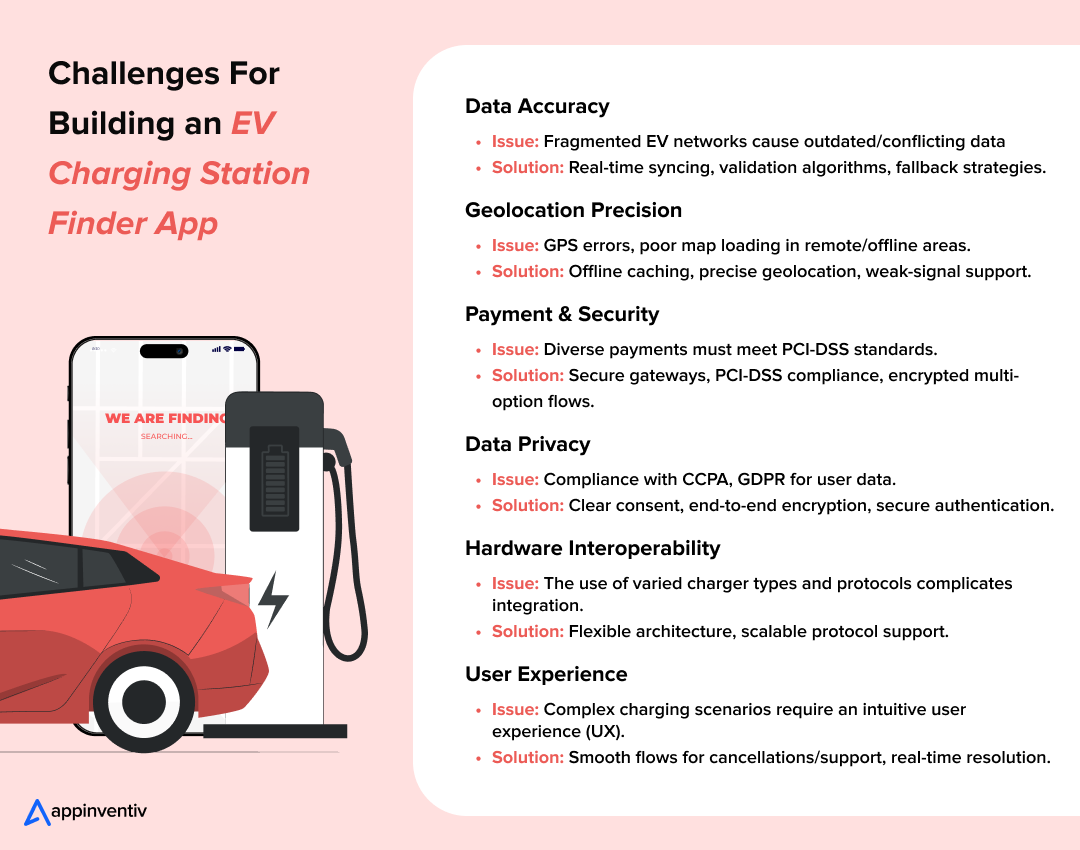
Data Accuracy and Reliability
Issue: Fragmented EV charging networks with multiple APIs (e.g., Open Charge Map, NREL, Hubject) lead to conflicting or outdated data. Network downtimes or hardware failures cause stale information.
Solution: Implement real-time data syncing, robust validation algorithms, and fallback strategies to ensure reliable, up-to-date charger availability.
Mapping and Geolocation Precision
Issue: GPS inaccuracies, poor map loading in remote areas, or offline scenarios can frustrate users or leave them stranded.
Solution: Optimize for edge cases with offline map caching, precise geolocation algorithms, and support for weak-signal environments like underground garages or rural areas.
Payment Ecosystem and Security Compliance
Issue: Supporting diverse payment methods (credit cards, digital wallets) while complying with PCI-DSS standards is complex and critical to avoid legal penalties.
Solution: Integrate secure payment gateways, ensure PCI-DSS compliance, and provide seamless multi-option payment flows with strong encryption.
Data Privacy Regulations
Issue: Compliance with the CCPA, GDPR, and other privacy laws is mandatory for apps that collect user data, requiring clear consent and secure data handling.
Solution: Implement transparent consent flows, end-to-end encryption technology, and secure user authentication to meet global privacy standards.
Challenge: Hardware and Network Interoperability
Issue: Diverse charger types, protocols, and proprietary standards complicate integration with backends and future compatibility with IoT or vehicle dashboards.
Solution: Design a flexible architecture to support multiple protocols and plan for scalable integrations with regular updates.
Challenge: User Experience Complexities
Issue: Variable charging session scenarios (such as reservations, wait times, and charger failures) require an intuitive user experience and robust support systems.
Solution: Create smooth UX flows for cancellations, delays, and support requests, backed by a reliable backend for real-time issue resolution.
Being aware of these challenges won’t eliminate them. Still, it prepares you to build a resilient, user-first product that stands out in a competitive market, helping you get the most out of the cost to hire an EV charging station finder app developer.
How to Win and Scale in a Crowded Market?
Building an EV charging station finder app is just the start; turning it into a thriving business means mastering how to generate revenue while strategically growing your user base. In this competitive space, understanding an effective monetization model for EV charging station finder app models, alongside smart growth tactics, will set you apart as one of the most strategic real-world examples of EV charging station finder applications, while helping you scale sustainably.
Monetization Strategies
App monetization strategies unlock revenue streams early on, helping fuel growth and sustainability for your EV charging app while enabling you to plan the budget for building an EV charging station finder app.
- Transaction Fees: Earn revenue by taking a small cut of payments processed for charging sessions, enabled through secure payment integrations and strong partnerships.
- Subscription Plans: Offer premium features that users – and especially fleet operators – are willing to pay for regularly, like reserved spots and detailed usage analytics.
- Sponsored Listings & Ads: Generate income through relevant advertising partnerships, ensuring ads add value without disrupting the user experience.
- Data Monetization: Leverage anonymized usage data to provide valuable insights to industry players while keeping user privacy intact.
Growth Strategies
Driving adoption and engagement requires focused efforts to build a loyal user base and stand out in a competitive market.
- Expand Features: Keep users hooked by adding valuable tools like route planning, trip optimization, and real-time charging diagnostics.
- Focus on Niche Markets: Dominate smaller, fast-growing regions first to build a strong foundation before tackling the national stage.
- Build Community: Turn your users into advocates by creating spaces for reviews, forums, and social sharing that nurture connection and trust.
How Can Appinventiv Help You Build and Scale a Market-Ready EV Charging App?
Building an EV charging station finder app isn’t just about coding – it’s about understanding ecosystems, user behavior, regulatory frameworks, and scaling fast. That’s where our EV charging station finder app development company comes in.
With 1,000+ digital products delivered across 15+ industries, Appinventiv is the EV app development company that can help turn your EV charging app vision into a powerful, scalable, and revenue-generating solution.
We bring deep experience in building mobility, energy, and location-based platforms from the ground up. Our location-based EV charging station finder app development experts help you:
- Validate your idea and business model: Through discovery workshops and market research, we help you identify your app’s core value proposition, monetization potential, and go-to-market edge.
- Design intuitive, user-first experiences: Our design teams craft interfaces that simplify EV journeys – from charger discovery to seamless payments – across all user types.
- Integrate complex hardware and protocols: We work with OCPP, OCPI, and charging network APIs to ensure seamless communication between your app and real-world electric vehicle (EV) infrastructure.
- Embed analytics and optimization from day one: We bake in user analytics, usage patterns, and A/B testing frameworks to help you continuously improve your app post-launch.
- Ensure compliance, scalability, and security: From PCI-compliant payments to scalable cloud architectures and secure data storage, we build platforms ready for real-world growth.
Ready to bring your EV charging app to life? Contact our EV development experts today to discuss your unique needs and discover how Appinventiv can turn your vision into a successful, market-leading solution.
FAQs
Q. How do you build an EV charging station finder app?
A. EV charging station finder app development begins by identifying your core use cases—urban users, fleet operators, or travelers—and defining your MVP features, such as real-time charger maps, availability, filtering, and payment options. Then, choose a scalable tech stack (e.g., Flutter + Node.js) and integrate an API for the EV charging station locator app, such as Open Charge Map or ChargeHub, build out UX for different user types, and test extensively before launch.
Q. How do you integrate the app with various types of EV charging stations and payment gateways?
A. The integration part of app development for finding electric vehicle charging stations typically relies on public or proprietary APIs from charging networks. For broader compatibility, adopt the OCPP (Open Charge Point Protocol), which standardizes communication between chargers and your backend. Payment integration can be achieved via Stripe, PayPal, or custom EV wallet systems, ensuring PCI-DSS compliance and secure tokenization.
Q. How long does it take to build an EV charging station finder app?
A. The electric vehicle charging station finder app development timeline depends on app complexity. A basic MVP may take 3 to 4 months, while a full-featured, enterprise-grade solution with route planning, billing, analytics, and fleet features can take 6 to 9+ months, including testing and integrations.
Q. How does the app adhere to industry-specific protocols and standards, such as OCPP (Open Charge Point Protocol)?
A. The backend of your EV charging station finder app should implement OCPP 1.6 or 2.0.1 to enable standardized, two-way communication with charging stations – covering session management, meter values, remote start/stop, and firmware updates. Many charging hardware providers already support OCPP, which simplifies integration and future scalability.
Q. How do you integrate user behavior analytics to improve mobile app functionality?
A. Use tools like Firebase Analytics, Mixpanel, or Amplitude in your EV charging station locator app development process to track how users search for chargers, which filters they apply, how long they dwell on a station page, and where they drop off. These insights help you refine UX, recommend better stations, improve conversion, and even predict demand hotspots.
Product Development & Engineering
IT Managed & Outsourcing
Consulting Services
Data Services
Didn't find what you're looking for? Let us know your needs, and we'll tailor a solution just for you.



















